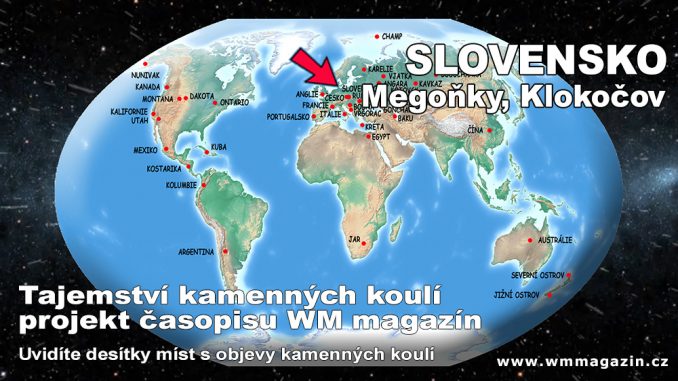Stone balls in Slovakia Megoňky stone balls

Stone balls stir the world’s public. The first finds in Costa Rica are mentioned in every tourist guide. What is missing in world literature, however, is any mention of recent discoveries of stone balls on the territory of the Czech and Slovak Republic! Did you know that?

First news from the Czechoslovak Borderlands
The first report on the discovery of stone balls in Slovakia appeared in 1995. After each blasting, we saw stone balls. Some of them are several metres in diameter. The little ones were taken by local people to their gardens. But many of them, including the largest one with a diameter of five metres, were destroyed by other blasts. Sandstone was still mined in the quarry in the 1980s. Today the quarry is abandoned. The stone balls were found on the Czech-Slovak border from Jablunkov over Megoňky to Klokočov.
Megoňky
The old quarry is located in Turzovská vrchovina (the Turzovka Uplands) on the state border between the Czech and Slovak Republics. A continuous belt of approximately 250 metres with the largest occurrence of stone balls runs through the Megoňka site and nearby Klokočov. The Kysuce region is geologically very interesting, especially because of the occurrence of crystals formed of various exotic minerals, which cannot be found elsewhere in Slovakia.

The perceptive observer can be attracted by several cracked and broken objects i.e. the remains of stone balls. This is probably the largest European site of stone spheres, comparable perhaps only to the finds in Costa Rica.
The best-preserved stone balls can still be seen today in the walls of the quarry. Since 1995, about 30 spheres with diameters ranging from 25 to 300 centimetres have been found here. Many of them have been taken away. The locals remember the unsuccessful attempt to move the largest stone ball with a crane.
The largest stone ball with a diameter of 3 metres is still in the quarry. Its body consists of a coarse-grained aggregate of stone grains from 2 to 4 centimetres, while the surface has a fine-grained finish. It is divided into two halves and it looks like an ideal cut. During the mining period, stone balls up to 5 metres in diameter were exposed and blasted in the quarry. According to geologists, the stone balls could have been formed by some tension and rotation in the rock, while others believe it is a spherical detachment of the rocks.

Near the largest ball, another with a smooth surface was found. Its top is about 35 cm high. The diameter is estimated to be approximately 85 centimetres. In the quarry you can see other balls embedded in the rock walls, in the northern part there is a bed of a fallen ball with an estimated diameter of 5 m.
Another stone ball with a diameter of 180 centimetres can be found above the quarry. It is embedded in the rock and it has begun to erode severely.

Above the quarry near the state border, there is a stone ball with a diameter of 120 centimetres. The upper stone ball part exposed to water and frost is damaged, the lower protected part with the fine grain is in good condition.
Not far from the quarry there is a hill called Hromová hora (Thunder Mountain), which attracts lightning during storms. Tomáš Bzdilík, the owner of the land below the mountain, led me deep into the forest to show me a preserved stone ball with a diameter of 165 centimetres. It is almost perfect with a fine-grained surface reminiscent of “stucco”.

There are many fragments of former stone balls scattered around the area whose isolated finds have also been reported from the nearby settlements of Jelitova, Raková and Kornice.
Source: wmmagazin.cz
